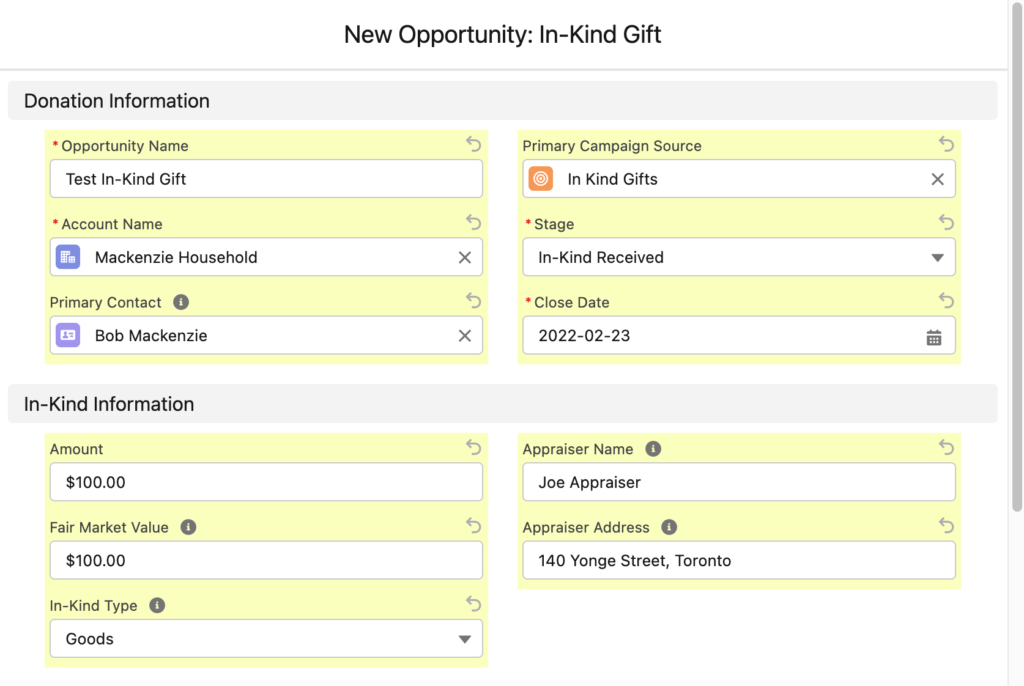Accepting gifts-in-kind (GiK) can be a bit complicated for Canadian nonprofits. Simply issuing a CRA-compliant receipt is a clunky process, in part because determining the fair market value (FMV) of an item can require significant time, money and effort, potentially draining staff time and resources.
Some nonprofits fear being audited if they accept in-kind gifts – something that no charity wants to go through.
In addition, most nonprofit CRMs simply don’t have the capability to issue a gift-in-kind receipt in an efficient manner, if at all, leaving both the nonprofit and the donor stuck with disorganized records.
Consequently, many Canadian charities have decided to simply not accept gifts-in-kind, leaving potentially valuable donations on the table.
But imagine saying “yes” to your donor who’d like to give you their incredible collection of tools, or finally accepting those gorgeous hand-quilted blankets from your long-time supporter…
Wouldn’t it be amazing?
If the thing holding your organization back from accepting gifts-in-kind is paperwork, let’s look at a better way to receive, process, and report on gifts-in-kind.
With fundraisingManager from Salesforce, the powerful CRM designed specifically for nonprofits, Canadian nonprofits can now accept and acknowledge in-kind donations.
Let’s unwrap the complexities of accepting gifts-in-kind in Canada, and offer an easier way to make both donors and nonprofits happy.


Examples of Gifts-in-Kind
Before we begin, it’s important to note that only goods or items may be donated in-kind, not services. That said, countless items could be donated to Canadian organizations:
- Food
- Clothing
- Furniture
- Appliances
- Art, collectables & jewelry
- Vehicles
- Electronics
- Land
- Stocks, mutual funds & bonds
The goal with in-kind giving is to have a win-win situation where both the donor and the nonprofit benefit.
For example, in-kind giving is a great way for food producers to deliver critical supplies to food banks across the country. Non-perishable food donations are efficiently distributed to areas of highest need. And when combined with cash donations, food banks can help provide families with produce, meat and dairy items they otherwise couldn’t afford.
In the case of Habitat for Humanity, each house requires a ton of building materials, not to mention home furnishings after the home is built. It would be nearly impossible to build Habitat for Humanity homes without the generosity of individual and corporate donors.
Wood, nails, drywall, tile, appliances – endless items are donated annually to help build homes for Habitat families. The nonprofit gets what it needs to fulfill its mission, and the donor typically deducts the value of these items from their personal or company’s tax liability (consult your accountant for details).
Can I Donate My Services In-Kind?
Based on Canadian law, services are considered volunteer work and are therefore not tax-deductible in Canada.
However, nonprofits can consider doing an even exchange with a donor who wishes to donate a service. For example, a nonprofit can pay fair market value for a service such as photographing an event. Let’s say the photographer would typically charge $1,500.
The nonprofit would pay the photographer $1,500, and the photographer would write a separate cheque back to the charity for $1,500. While it may not be perfect, this even exchange of cheques can work well for people wishing to donate their services and for the nonprofits that wish to receive them.
Fair Market Value Explained
- The highest dollar value you can get for your property
- in an open and unrestricted market,
- on the day that it was transferred,
- between a willing and knowledgeable buyer
- and a willing and knowledgeable seller
- who are acting independently of each other.
What this means is a nonprofit can assign a fair market value to a donated item either at the price the donor paid for it (with a receipt as proof), or the average price a charity could buy that same item on the open market. Oftentimes, a nonprofit could purchase a donated item roughly at wholesale cost.

How to Determine Fair Market Value (FMV) of a Gift in Kind (GiK)
To issue a GiK receipt, the charity must first determine Fair Market Value (FMV) of any goods donated. In most cases, FMV is determined based on the day the good is transferred to the nonprofit.
- For items worth less than $1,000, the nonprofit staff can usually assign the FMV.
- For anything worth over $1,000, the Canadian Revenue Agency recommends hiring a 3rd party appraiser. The appraiser’s name and address will be included on the GiK receipt.
Determining the fair market value of art, jewelry, collectables, land, and anything else that is subject to fluctuations in the market is best left to a professional appraiser.
Remember, any taxes paid when purchasing an item are not included in the fair market value.

Gift in Kind with advantage
Often, donors make gifts with no other exchange, but what happens when some amount of value is exchanged? An exchange between a donor and nonprofit creates an advantage and should be calculated for the GiK receipt.
A good example of an advantage is when a person donates to a nonprofit and receives a thank-you gift in exchange. Let’s say a person donates $150 and receives a winter hat worth $40 as a gift. The donor would receive a donation receipt for the difference, or $110.
The same applies to gifts-in-kind. If a nonprofit pays a relatively small fee of $500 in exchange for a specialized sorting machine with a fair market value of $2,500, the advantage ($500) is subtracted from the fair market value ($2,500). In this case, the donor would get a receipt for $2,000, or the FMV ($2,500) minus the advantage ($500).
Receipts can be generated with or without an advantage, and using the calculating tool within fundraisingManager will help your staff determine if a CRA receipt is required.
There are some additional nuances about advantages in regards to gift-in-kind acknowledgements and receipts. For more information, check out the CRA website.
Is There a Better Way to Process Gifts-in-Kind?
From a tax standpoint, gifts-in-kind are treated similarly to cash donations in that their FMV can be deducted from the donor’s tax liability.
The most important difference is that every gift-in-kind must be assigned an FMV, and each item will require its own CRA-compliant receipt. So instead of creating one receipt with multiple cash donations listed, each item needs to be listed and described individually.
If the receipting process for gifts-in-kind seems complex, it is. And it’s no wonder some nonprofits simply say “no” to receiving gifts-in-kind from their donors.
This is where the nonprofit-specific CRM, fundraisingManager from Salesforce becomes a very helpful tool. There’s simply nothing else currently available that even comes close to the power and ease that fundraisingManager offers for processing gifts-in-kind.
When using fundraisingManager, nonprofit staff can:
- Quickly acknowledge an in-kind gift using a unique in-kind gift email template
- Rest assured that all required fields are complete for issuing CRA-compliant receipts
- Attach a photo of the item or proof of value in the donation record
- Generate a protected PDF CRA receipt to send via email or in the mail
- Issue a replacement receipt
Sending donors receipts is one thing, but what about reporting? When it comes to tracking your organizations in-kind gifts, fundraisingManager makes it easy to view, sort and report on in-kind gifts. With a few simple clicks, you’ve got your report.
- No more maintaining separate databases that don’t talk to each other
- No more hand-configuring reports that don’t add up correctly
- No more duplicating entries
And perhaps best of all,
- No more saying NO to donors!
Due to CRA rules and the detailed nature of the receipts themselves, there isn’t currently a way to batch process in-kind gifts. However, once the gift information is entered into the system, staff can instantly view the details of the gift, including photos and appraisals, within the donor’s record.
How to Issue a Gift-in-Kind Receipt Using fundraisingManager from Salesforce
To view a quick 5-minute video of fundraisingManager’s gift-in-kind entry process, visit our how-to page here.
With fundraisingManager, accepting and sending receipts for gifts-in-kind is finally doable. Once you get started, this new feature might just inspire a whole campaign for in-kind giving.

How Can I Learn More About fundraisingManager from Salesforce?
If you’d like to learn more about how fundraisingManager from Salesforce can help your organization save time, raise more money, and efficiently manage your day-to-day operations, schedule an intro call with Tasha today.
Is fundraisingManager great? We think so! But you don’t have to take our word for it…
Resources:
Gifting & Receipting Q&A – https://www.canada.ca/en/revenue-agency/news/cra-multimedia-library/charities-video-gallery/cra-charities-communications-gifting-receipting.html
Gifts in Kind – the Basics
In Kind Donations w/ examples –https://www.giftfunds.com/blog/in-kind-donations-explained-with-examples/
GiK considerations –https://www.mwbca.org/stories/gift-in-kind-considerations
Software for nonprofits explanation on how to enter GiK – https://www.software4nonprofits.com/DonationManual/handling_gifts_in_kind.htm
fundraisingManager how-to –https://cloudstackservices.freshdesk.com/support/solutions/articles/36000356049-in-kind-gift-receipting-in-fundraisingmanager


